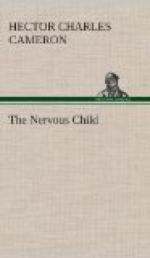nurse to move in and out of the room without protest.
If this fault has appeared and the child cannot be
left alone, our whole educational system is undermined,
and play will be profitless and over-exciting, because
it demands the constant participation of grown-up
people. As a preliminary to all improvement in
the management of a nervous child, we must see to it
that he becomes accustomed to being alone. We
must so arrange his nursery that he can do no damage
to himself. Scissors and matches must not be
left lying about, and a fireguard must be fixed in
position so that it cannot be disturbed. Then,
disregarding his protests, the nurse must leave him
to himself, at first only for a moment or two, re-entering
the room in a matter-of-fact way without speaking to
him, and again leaving it. Soon he will learn
that a temporary separation does not mean that we
have abandoned him for all time. Then the period
of absence can be gradually lengthened till all difficulty
disappears. Once his attention is removed from
the grown-up people who mean so much to him, his natural
impulse to explore and experiment with his playthings
will show itself. Those toys are best which are
neither elaborate nor expensive. For a little
child a small box containing a miscellaneous collection
of wooden or metal objects, none of them small enough
to be in danger of being swallowed, forms the material
for which his soul craves. Everything else in
the room may be out of his reach. A dozen times
he will empty the box and then replace each object
in turn. He will arrange them in every possible
combination, and then sweep the whole away to start
afresh.
At eighteen months of age observation and imitative
capacity will have made more complex pursuits possible.
As a rule the objects which are most prized and which
have most educative value are those which lend themselves
best to the actions with which alone the child is
familiar. Hence the supreme importance of the
doll and the doll’s perambulator. The doll
will be treated exactly as the child is treated by
the nurse. It will be washed, and dressed, and
weighed, and put to bed in faithful reproduction of
what the child has daily experienced. Dusting,
and sweeping, and laying the table will be exactly
copied. If a child has no opportunity of being
familiar with horses, if he has not seen them fed,
and watered, and groomed, and harnessed, he may not
find any great satisfaction in a toy horse, or pay
much attention to it, no matter how costly or realistic
it may be.
In the third year more precise tasks, such as stringing
beads, drawing, and painting, will play their part,
while at the same time the increased imaginative powers
will give attraction to toy soldiers or a toy tea-service.
Playing at shop, robbers, and rafts are developments
of still later growth. In the child’s games
we recognise the instinct of imitation—playing
with dolls, sweeping and dusting, playing at shop
or visitors; the instinct of constructiveness—making




